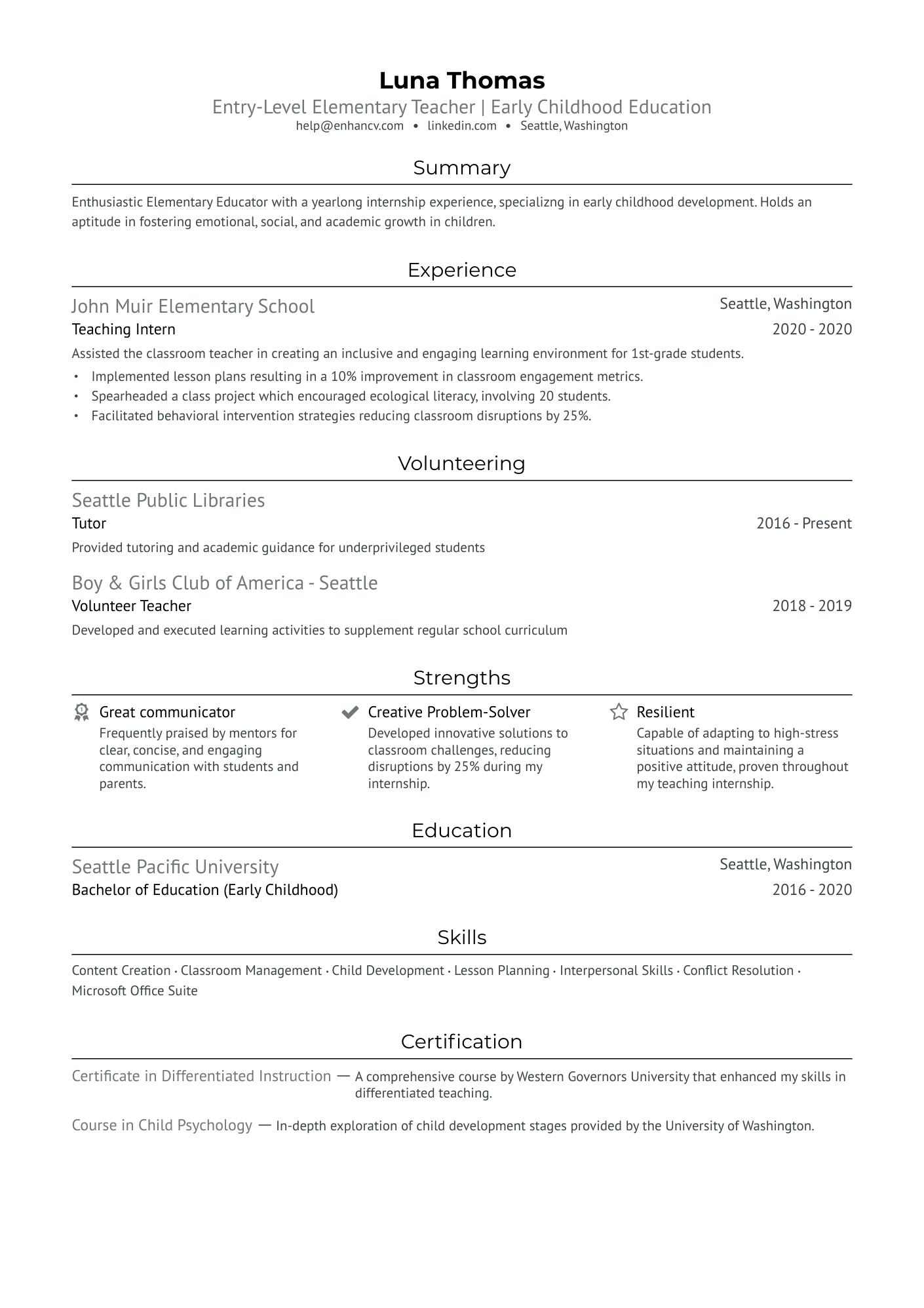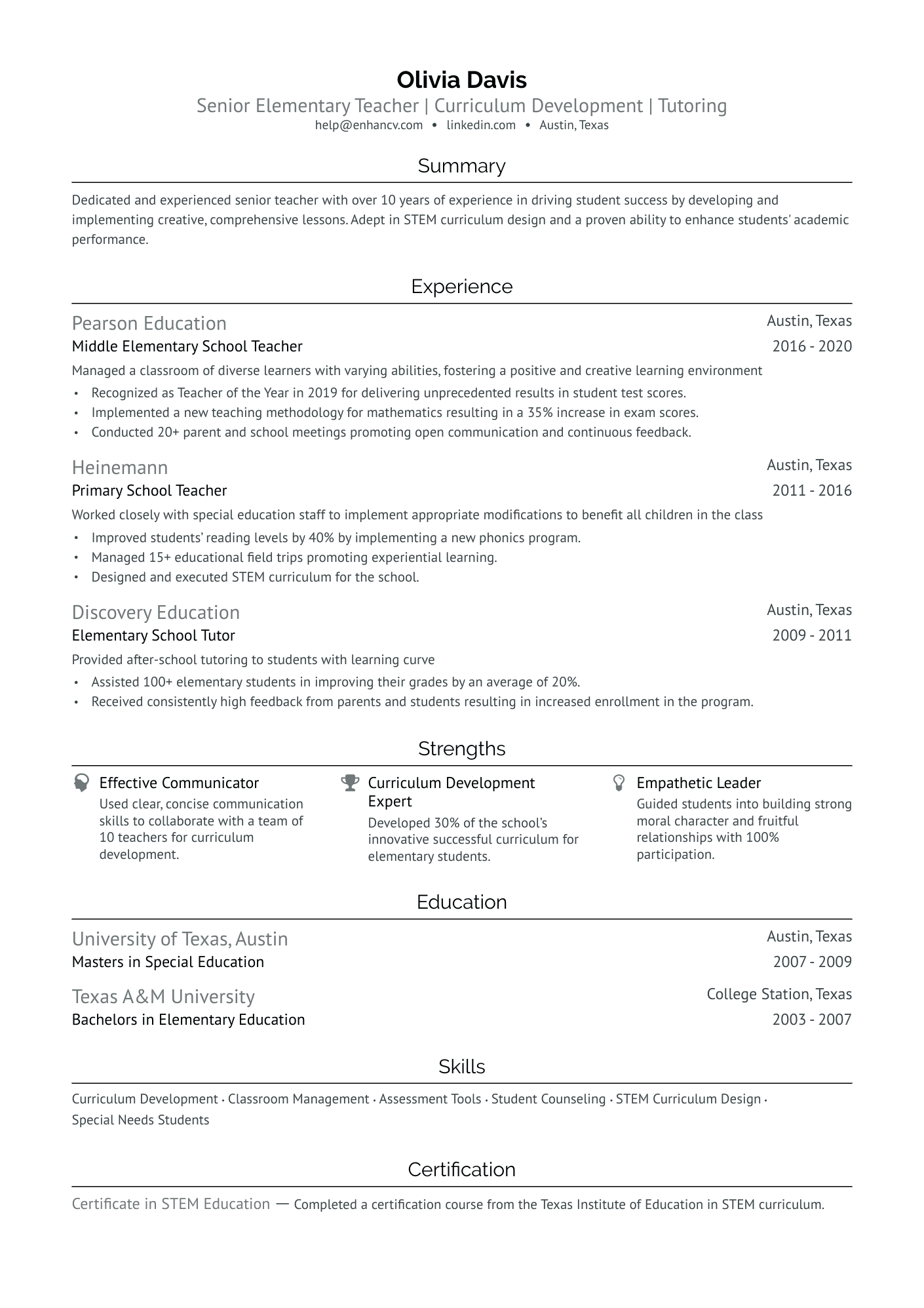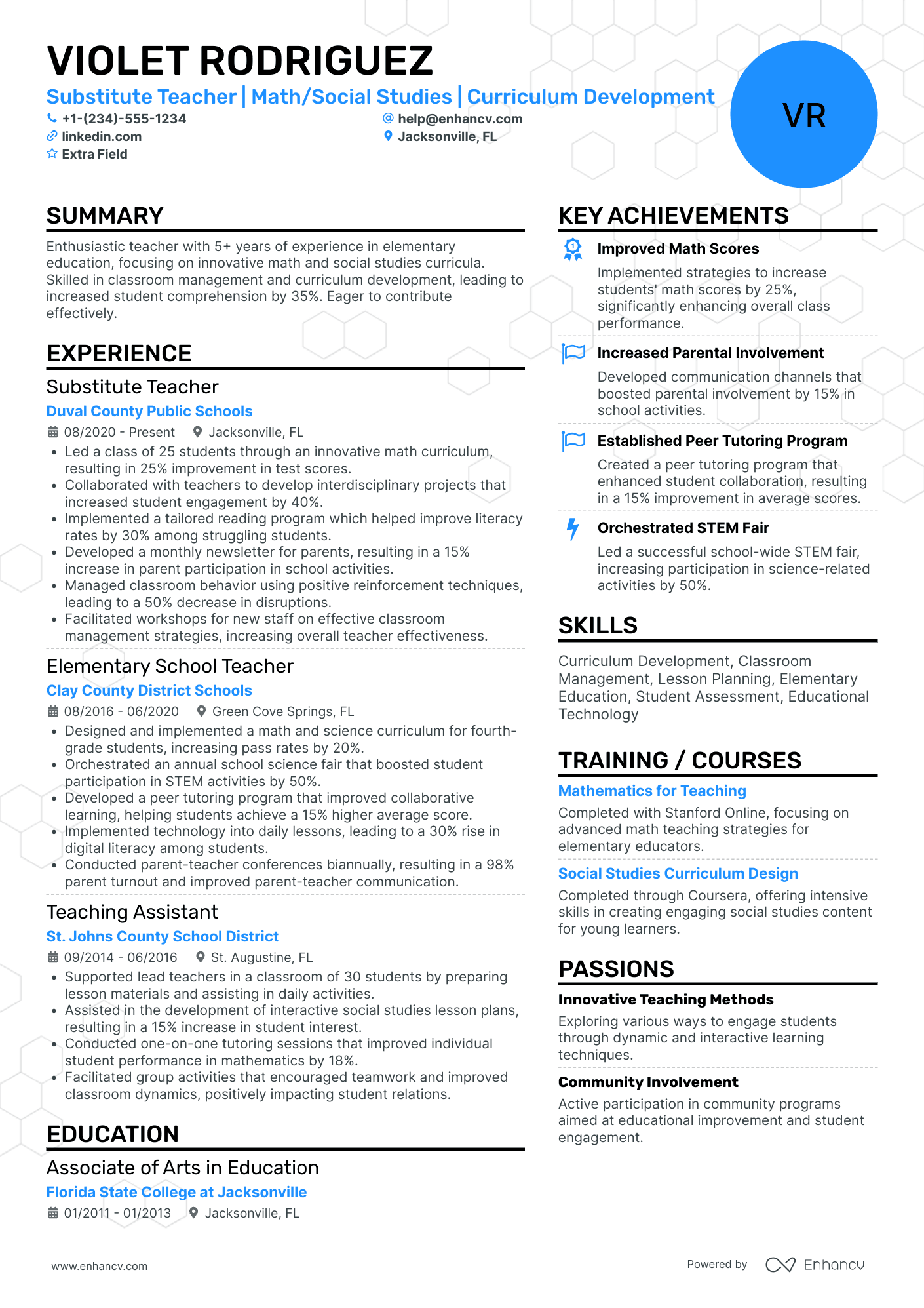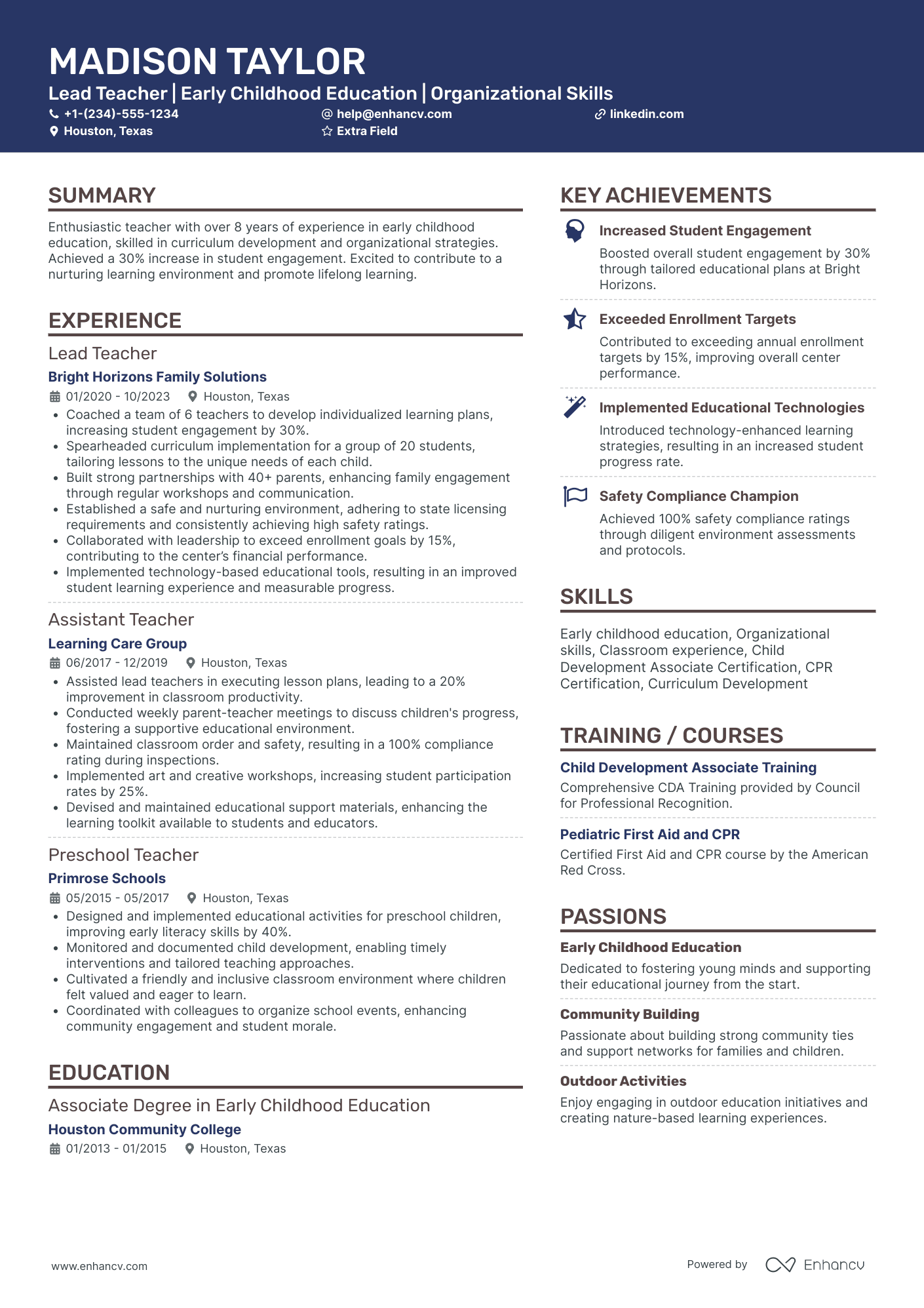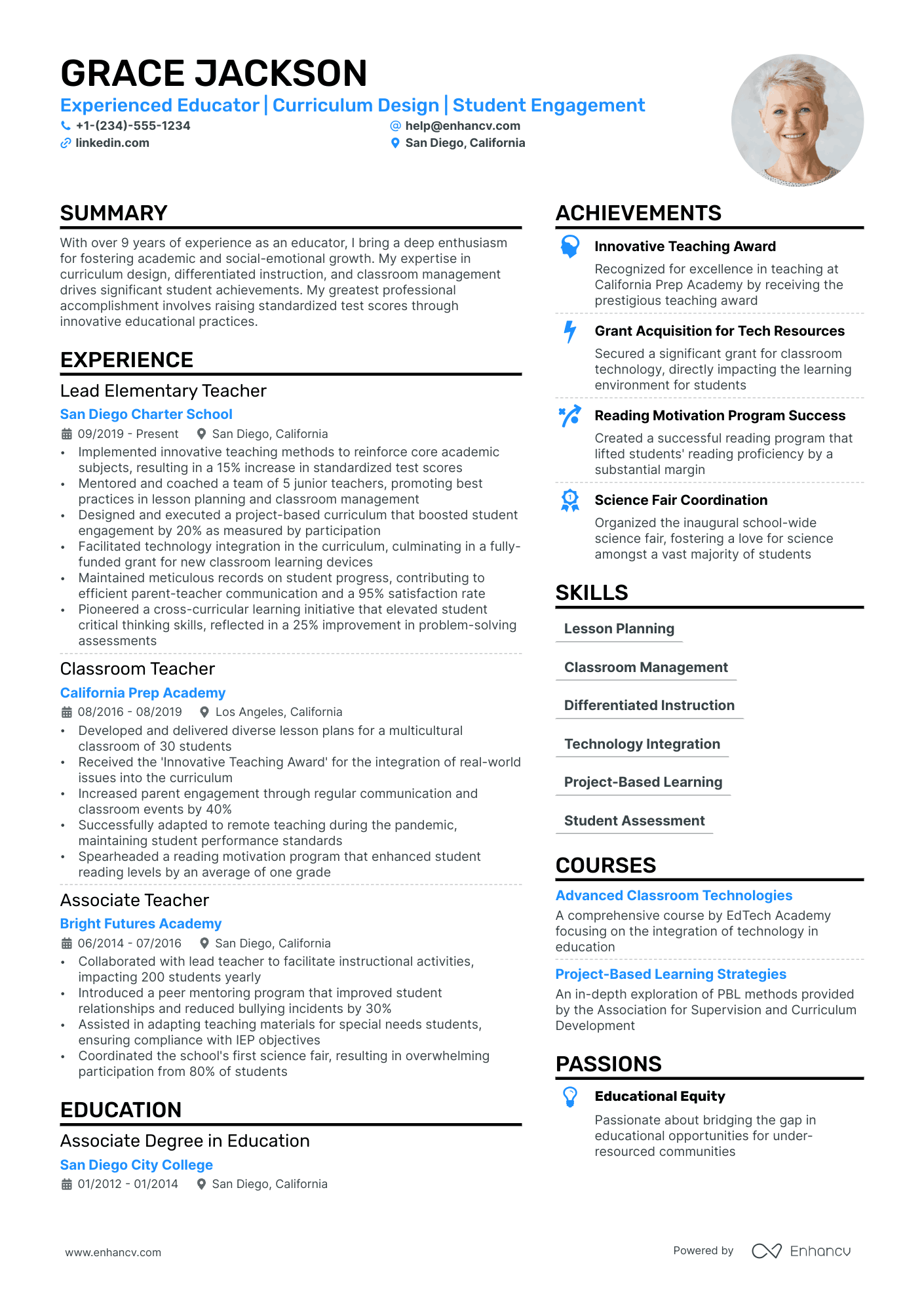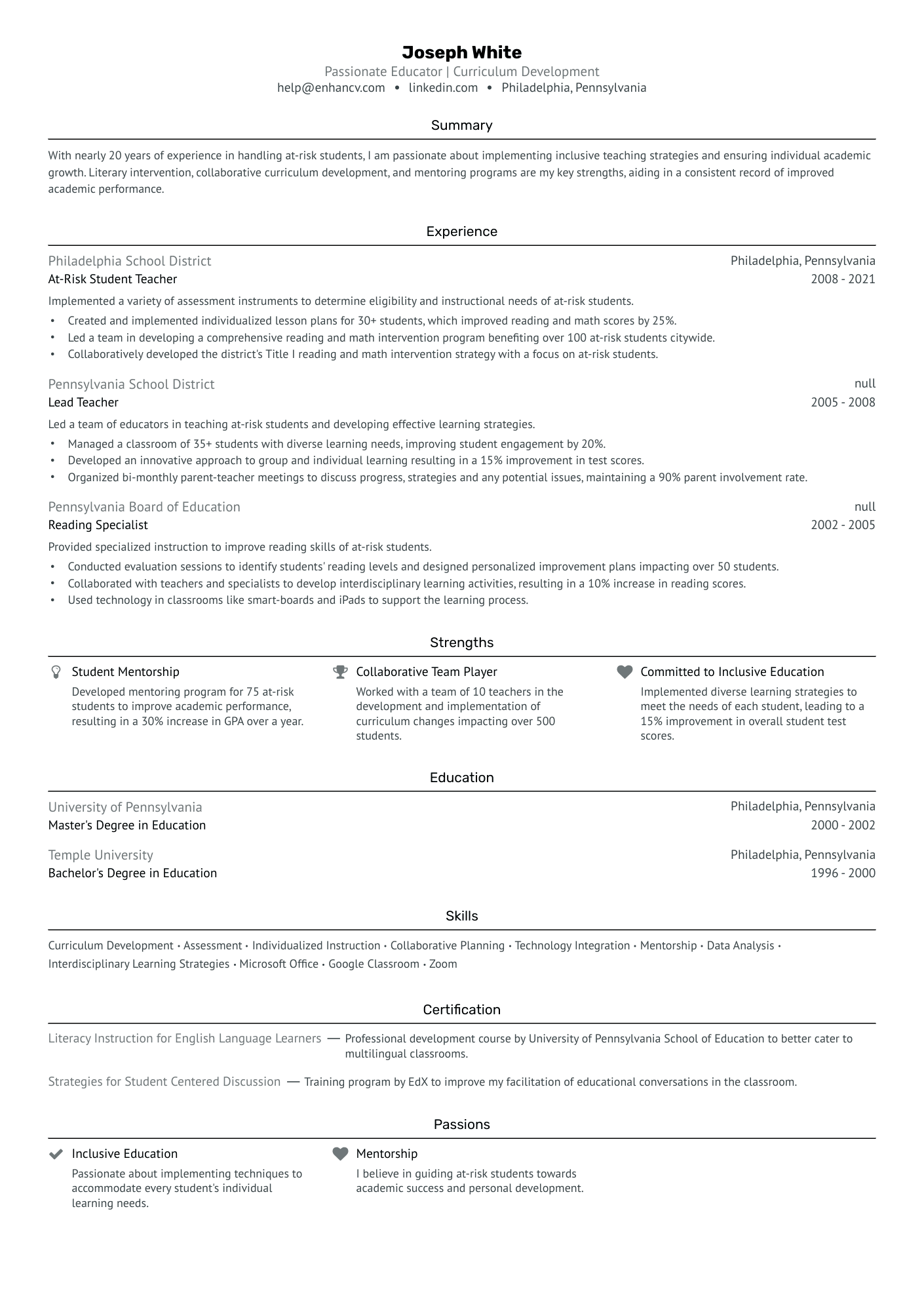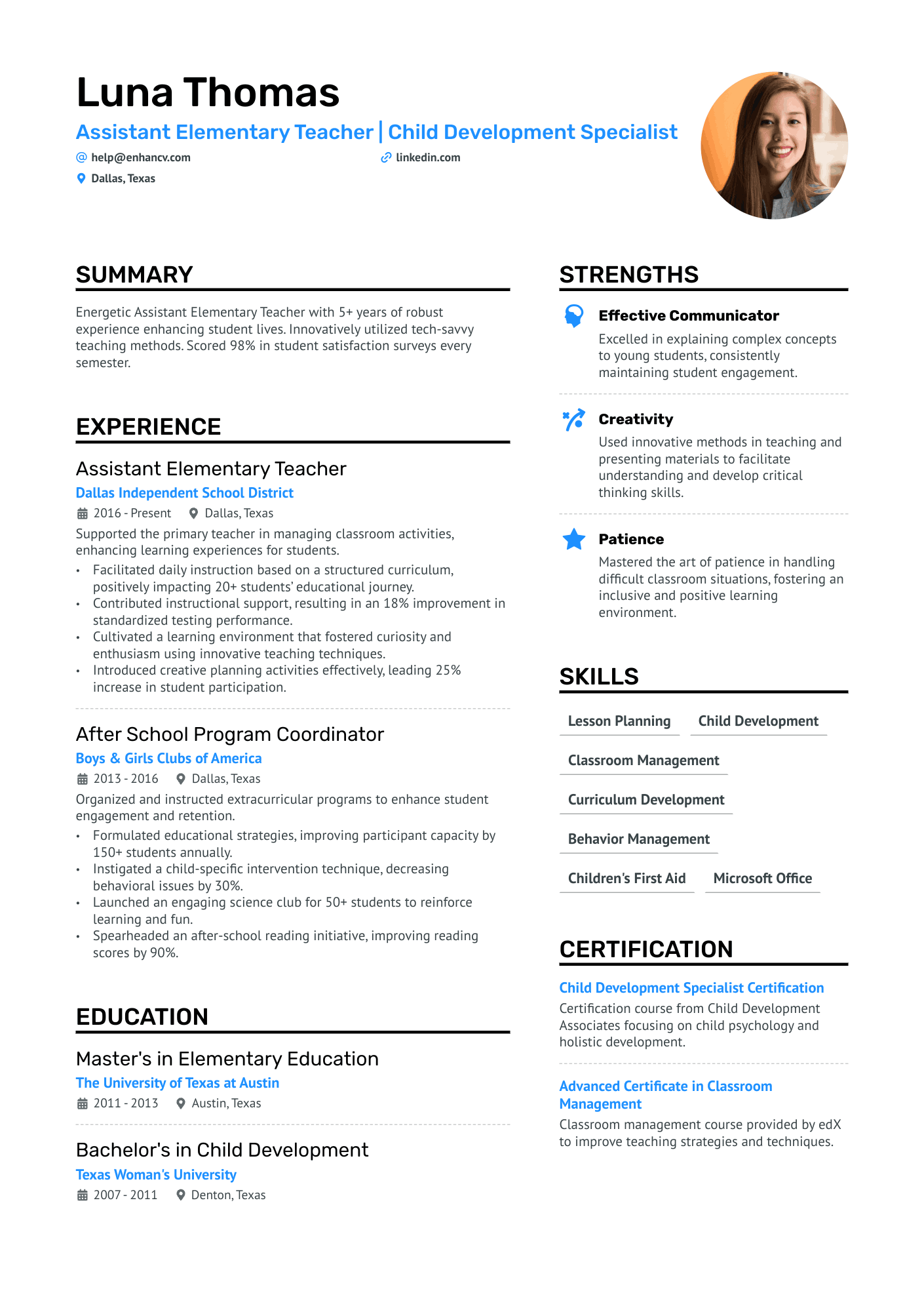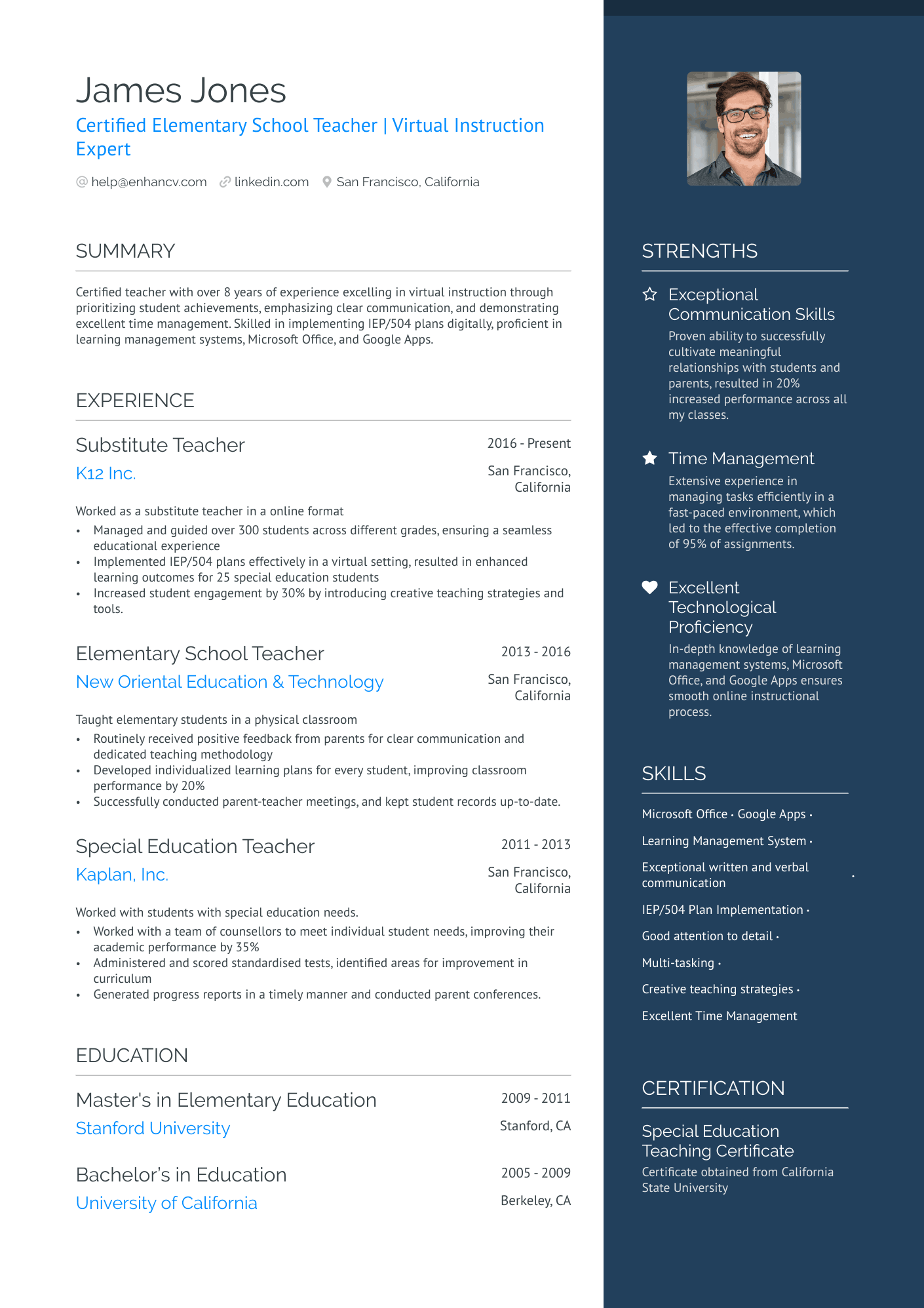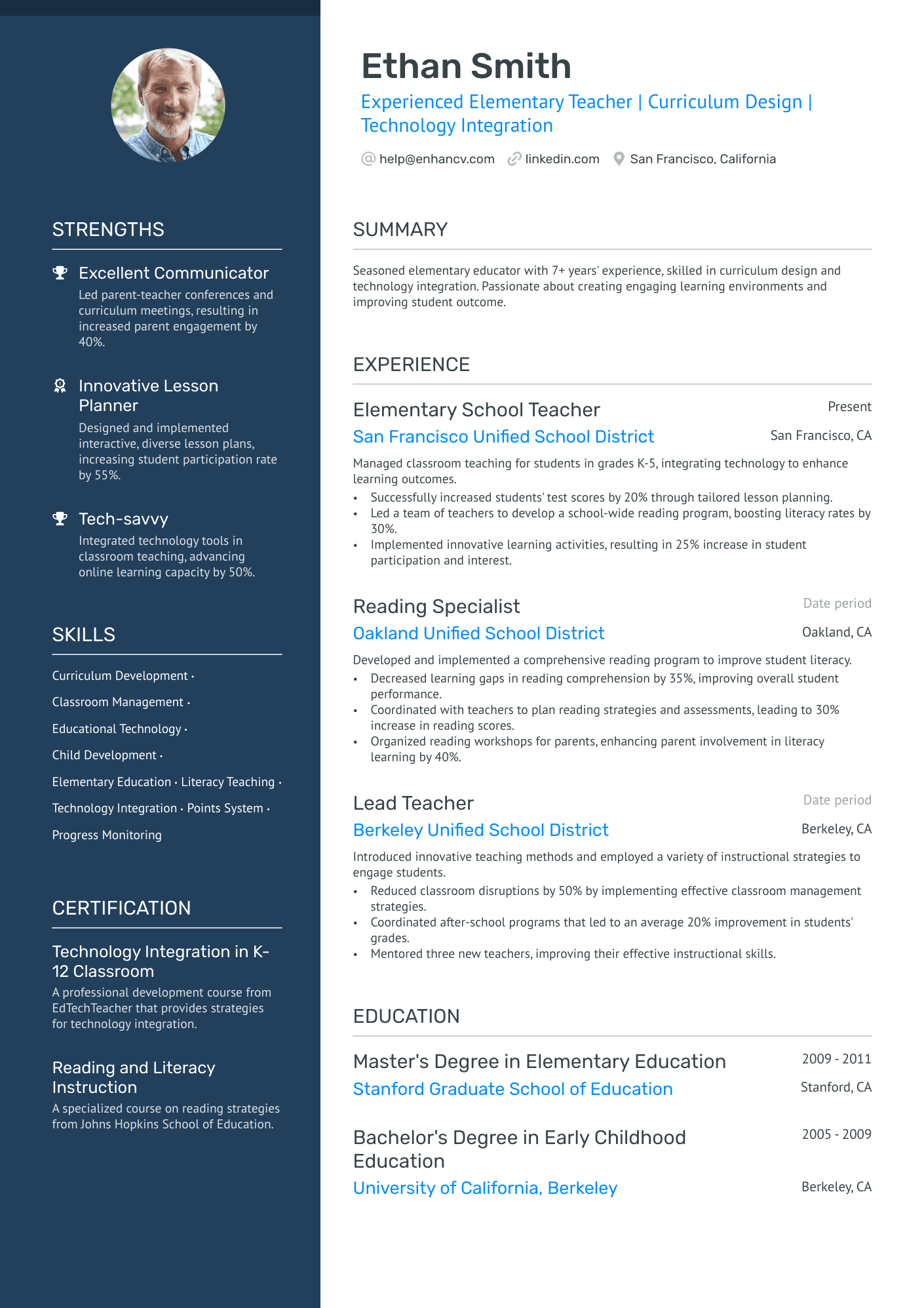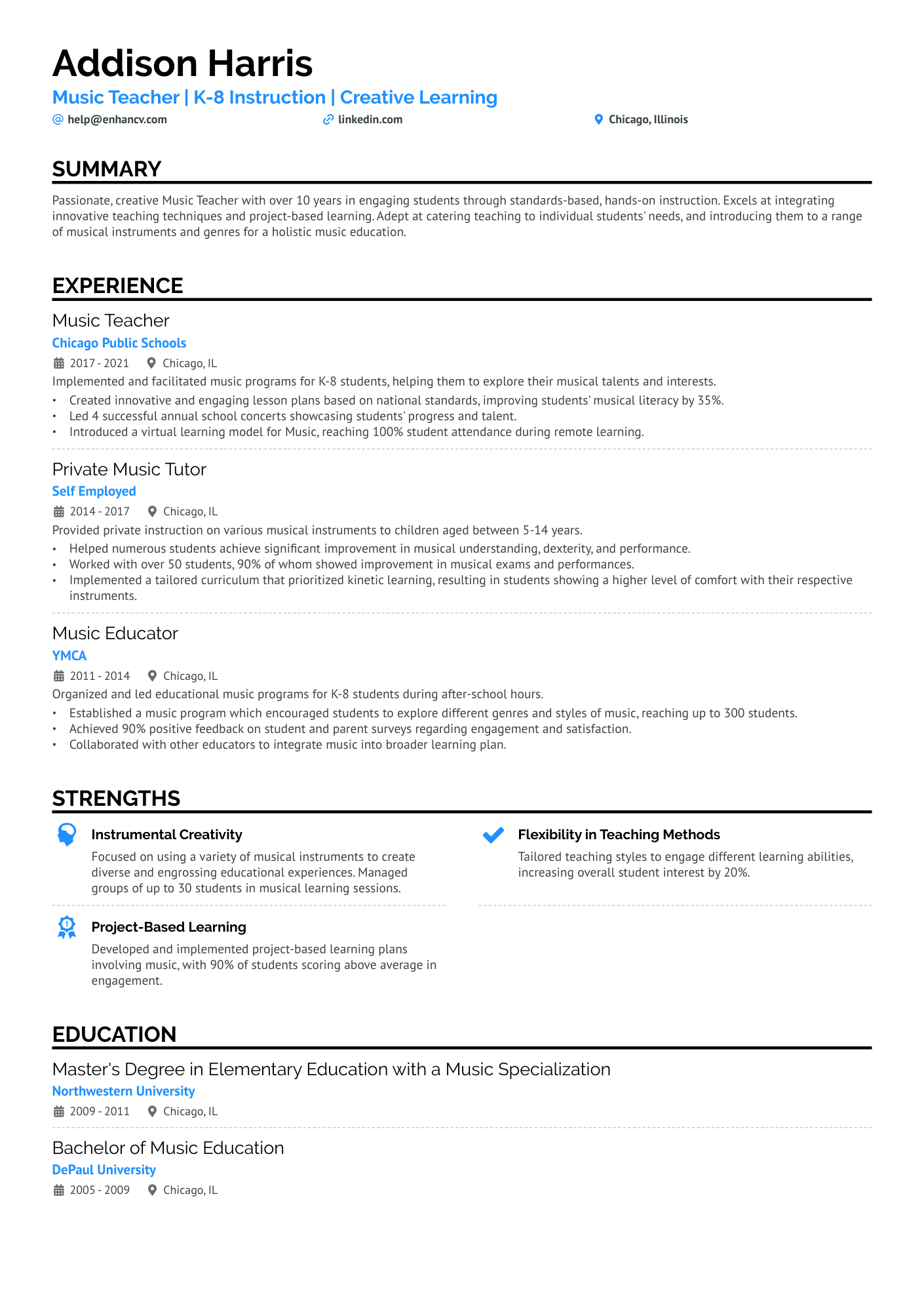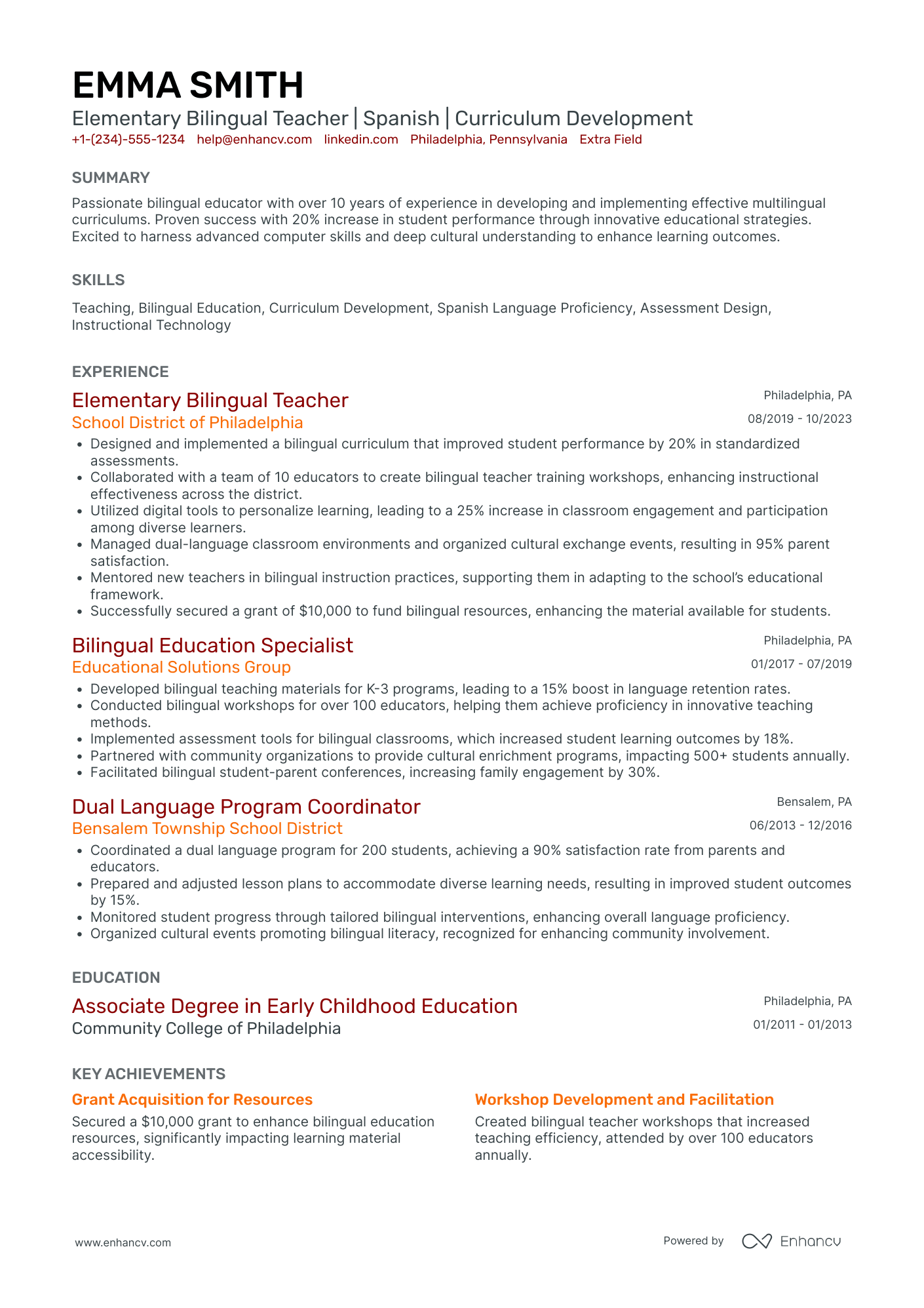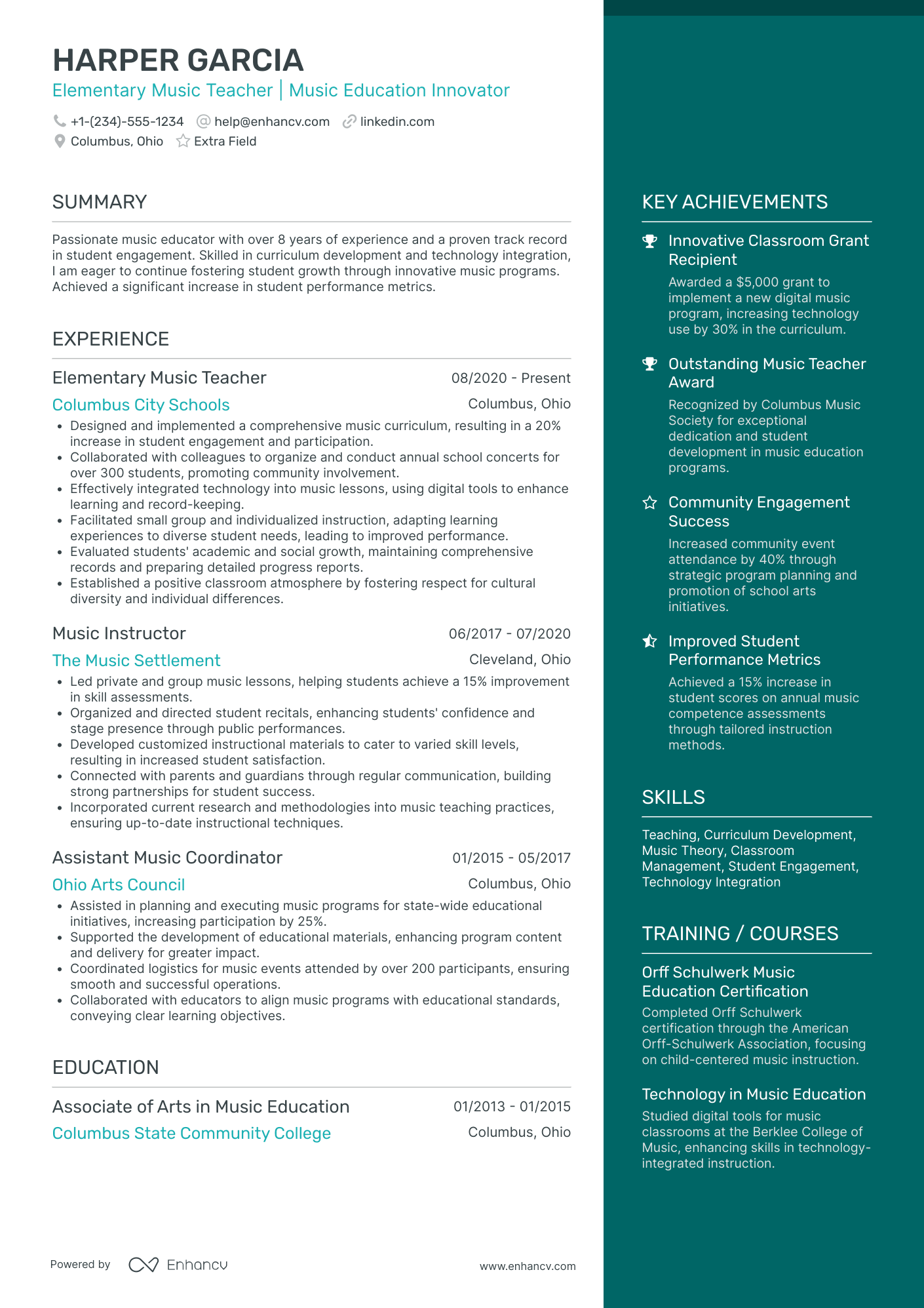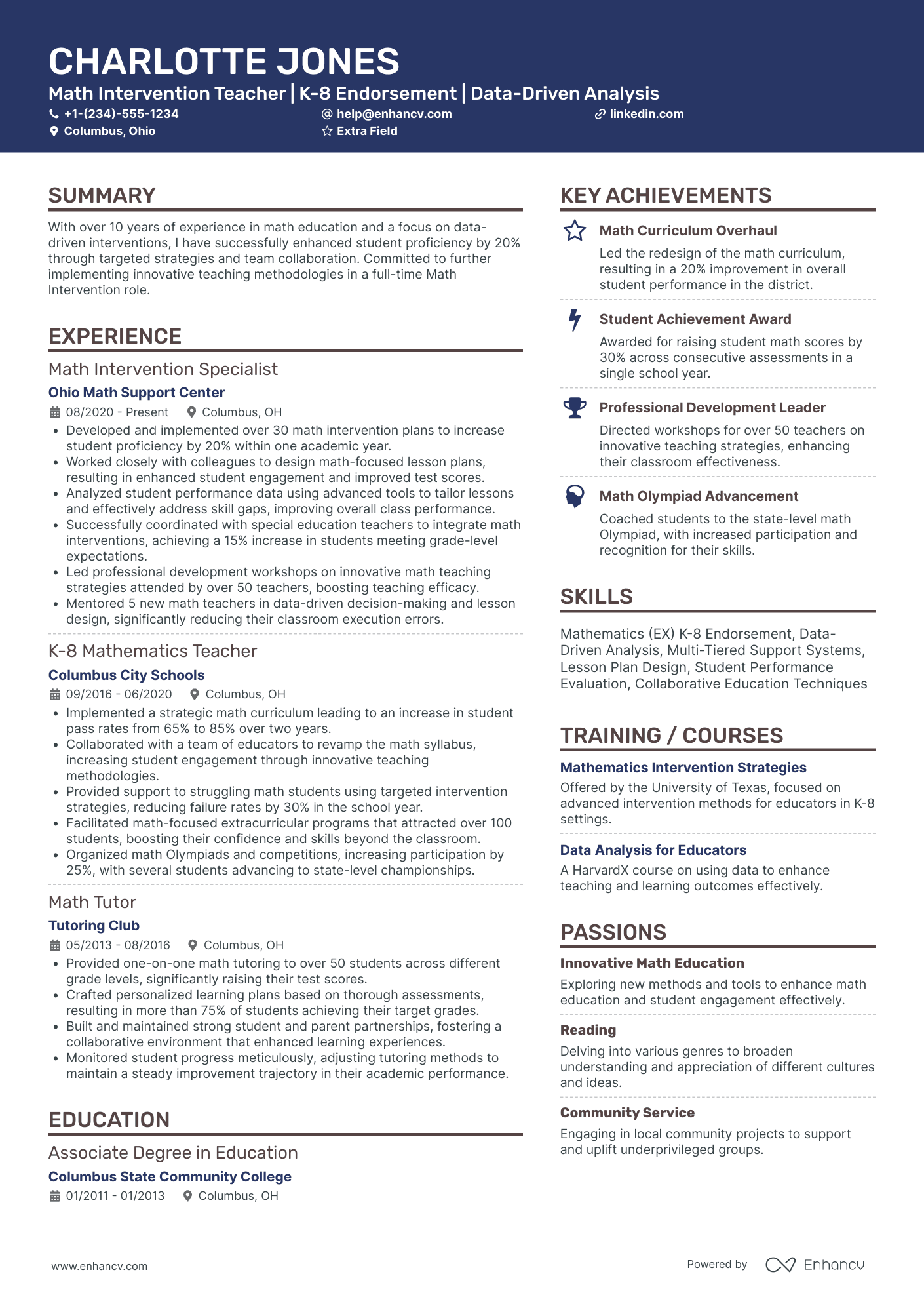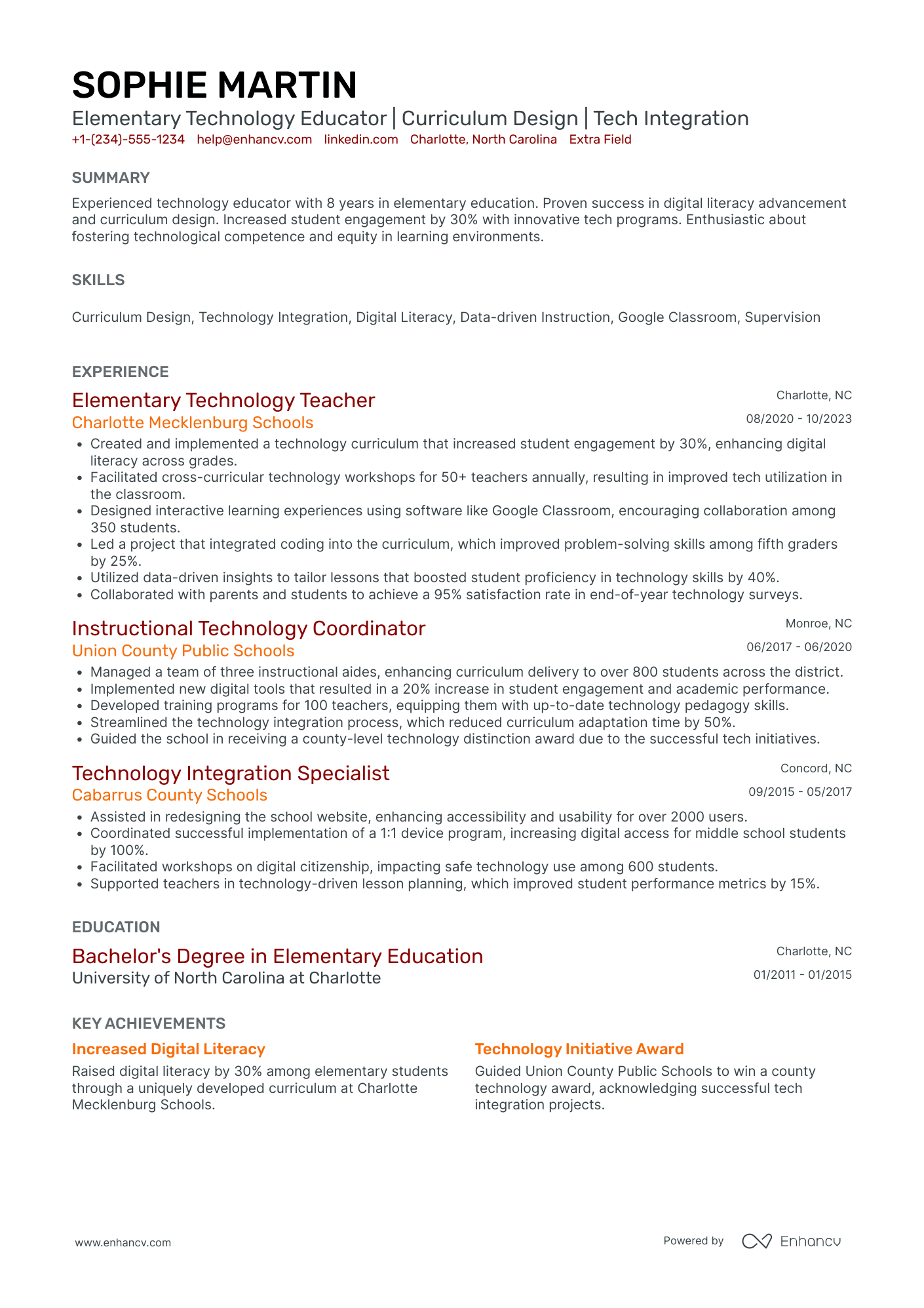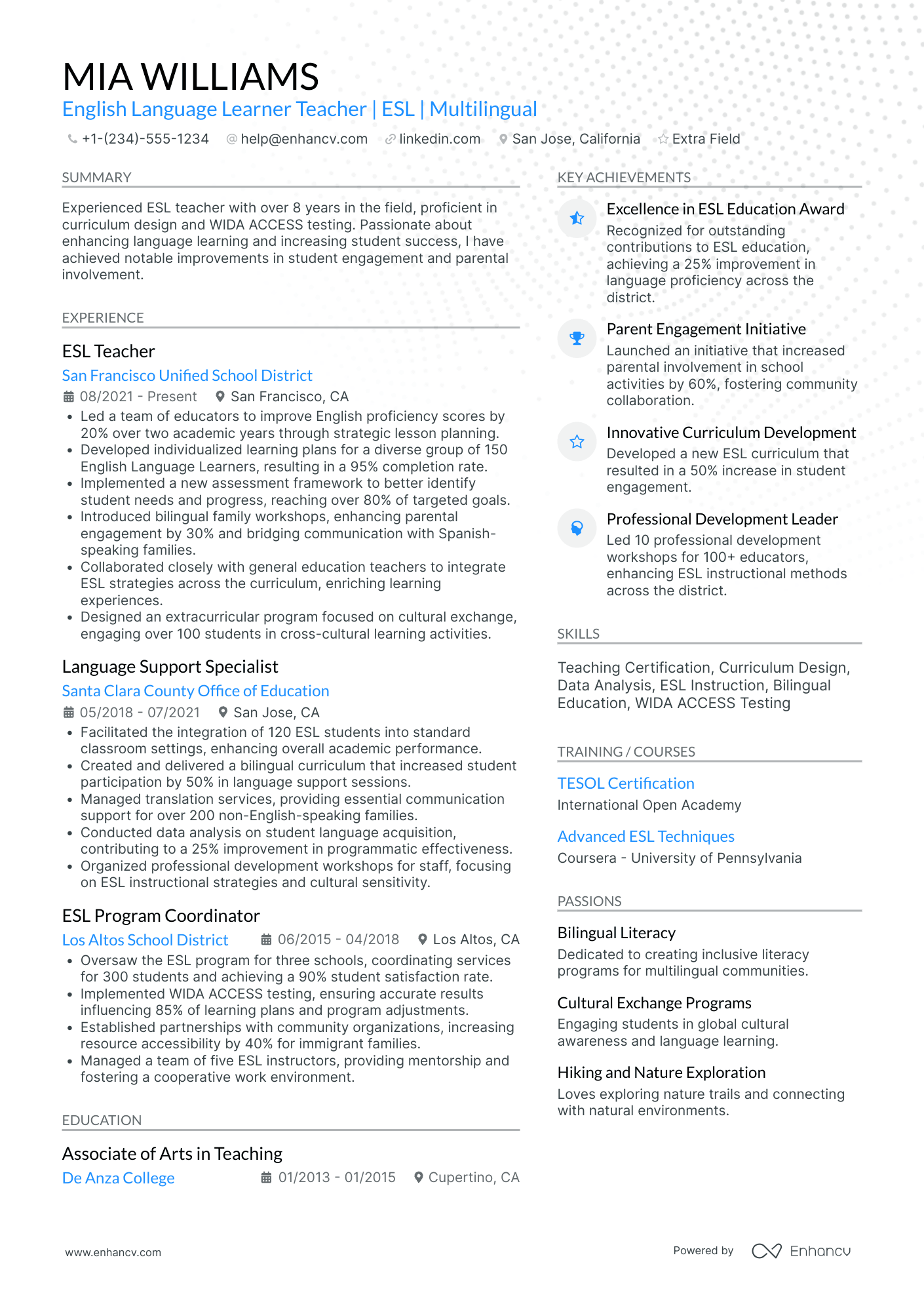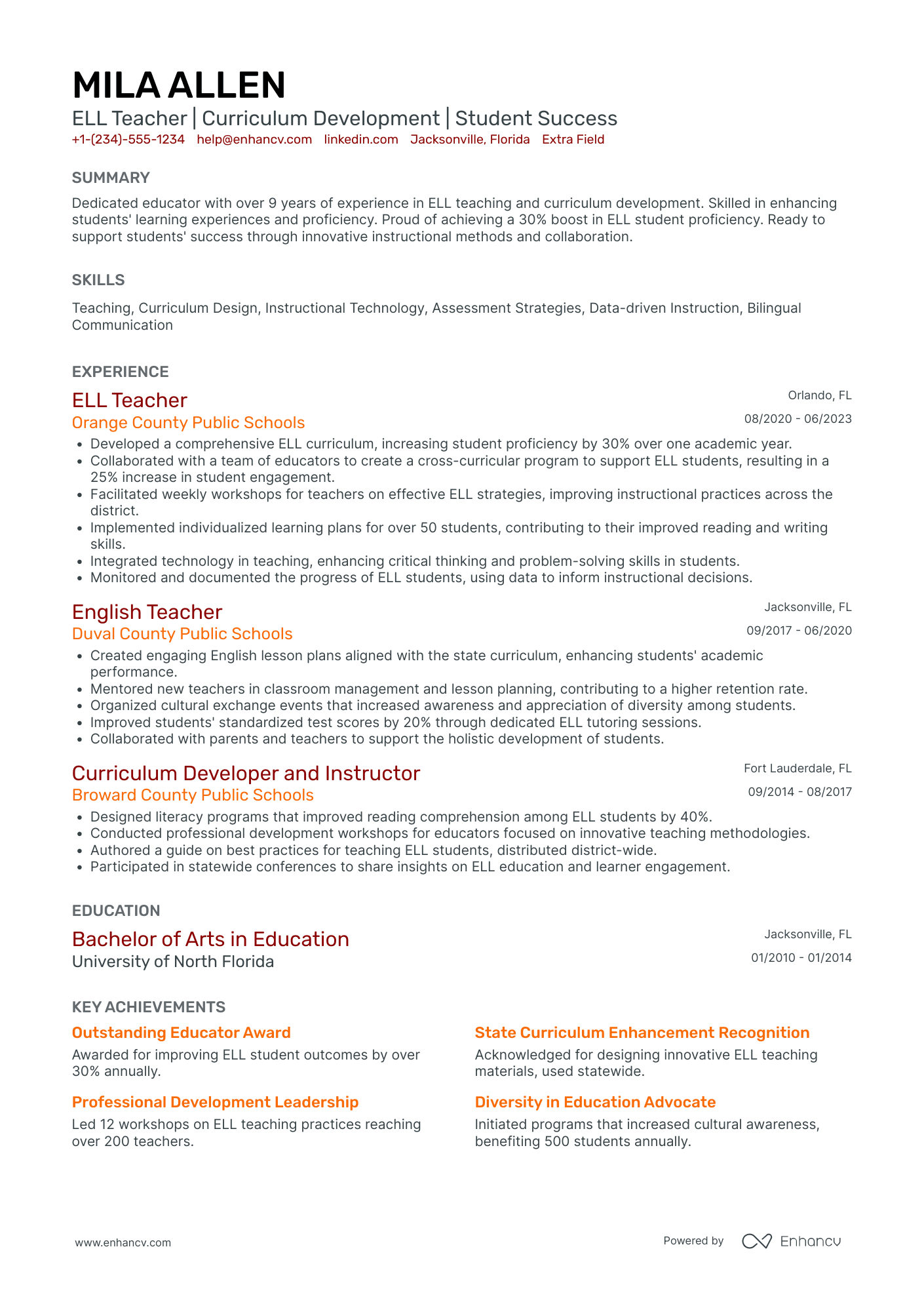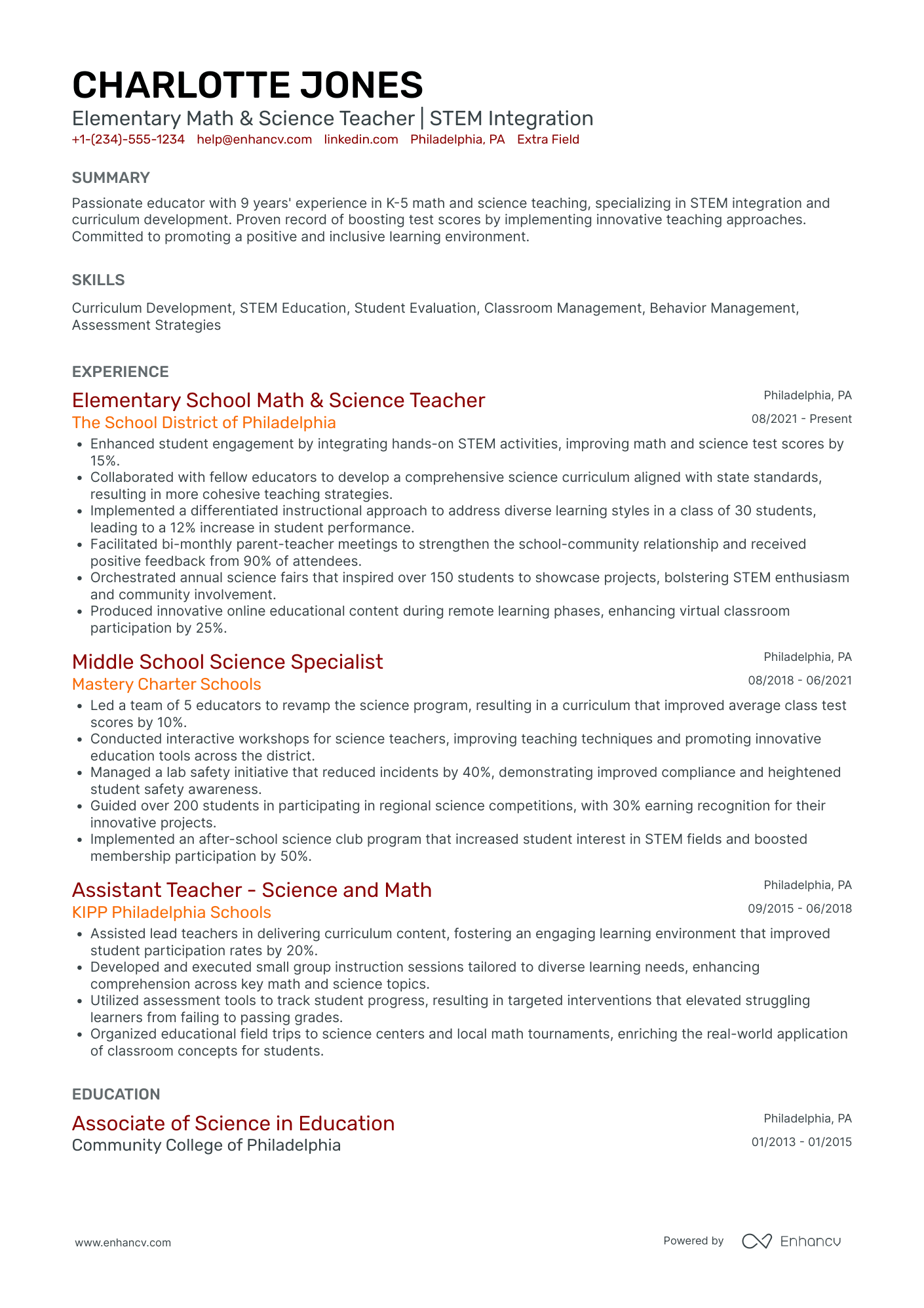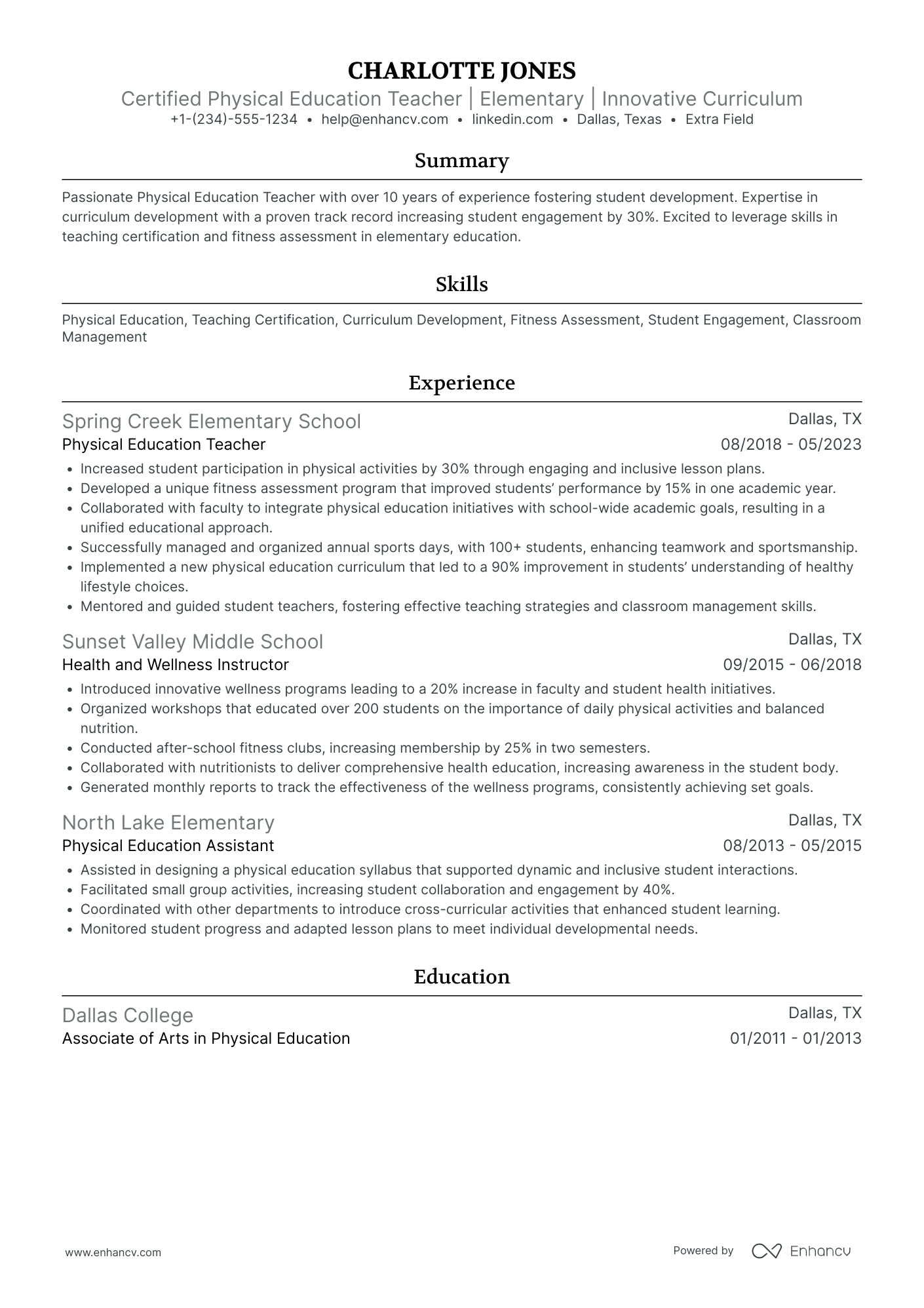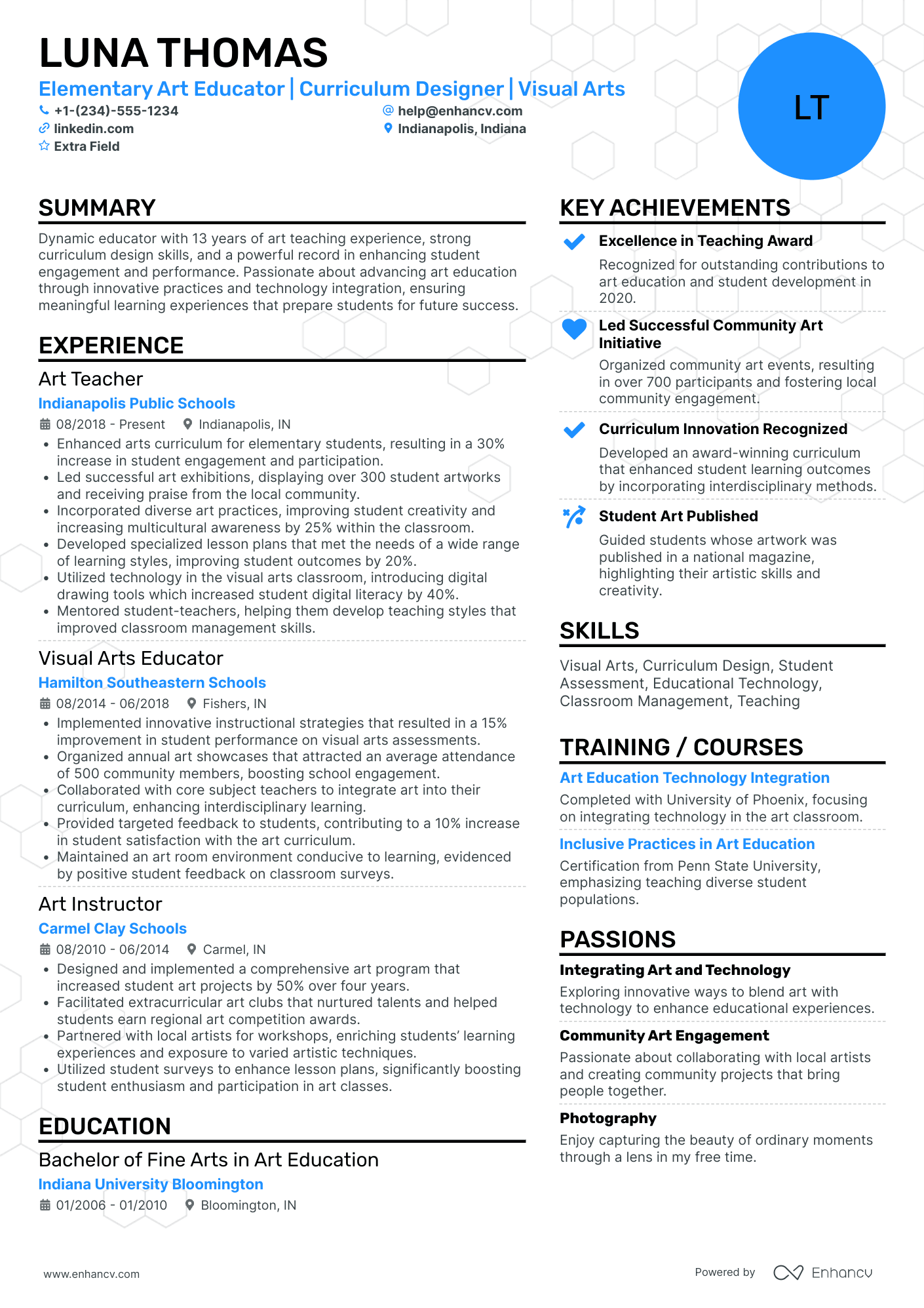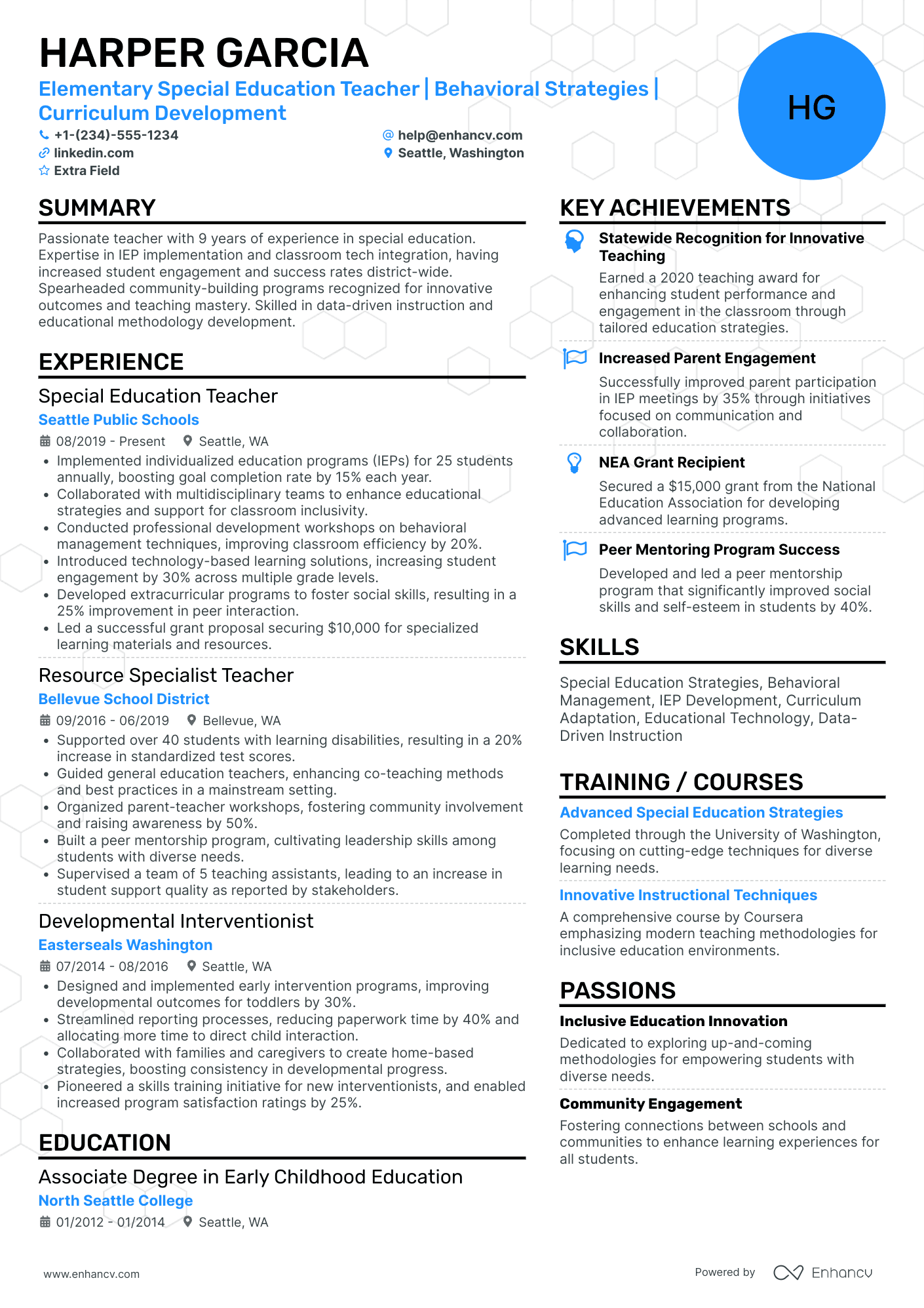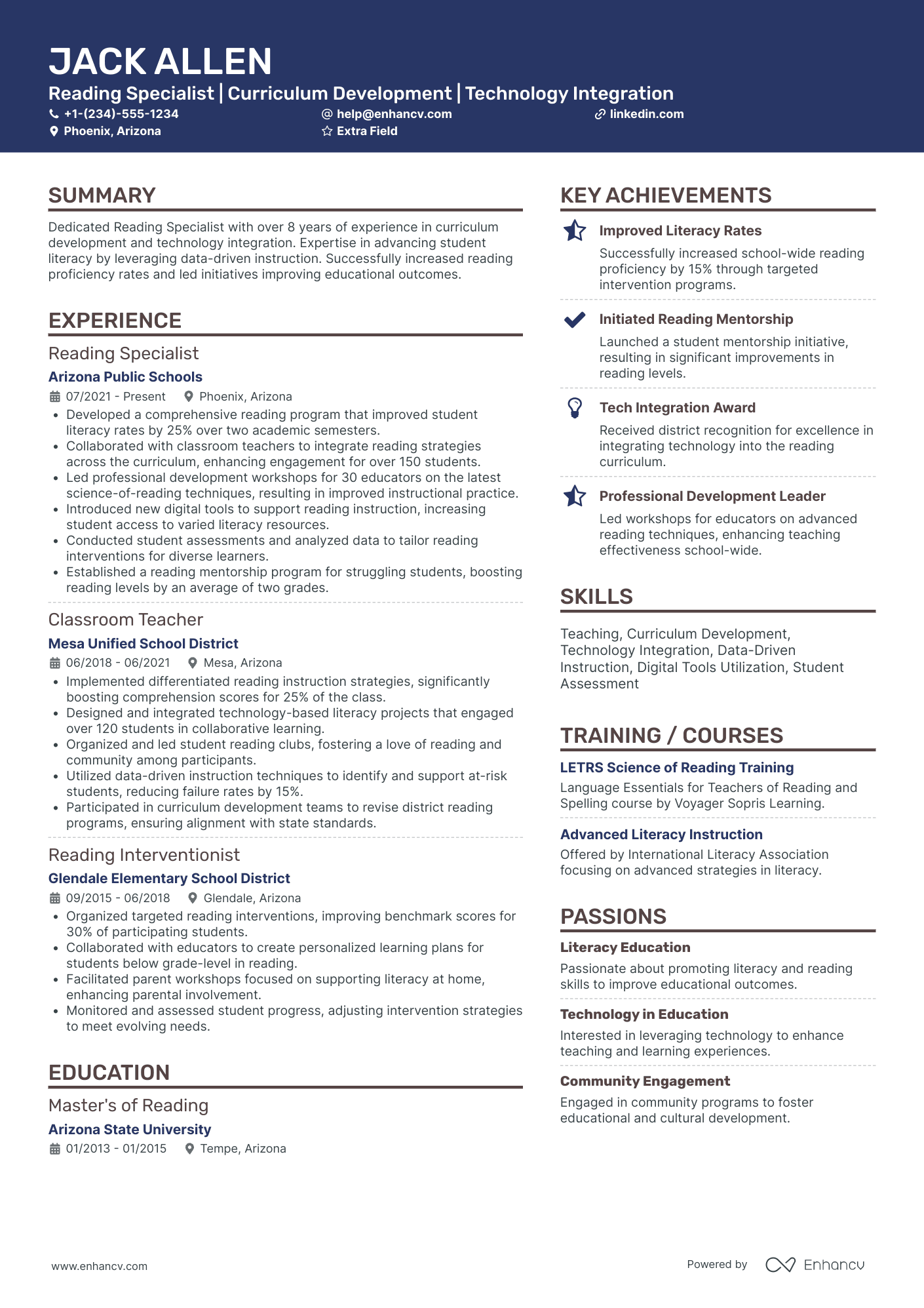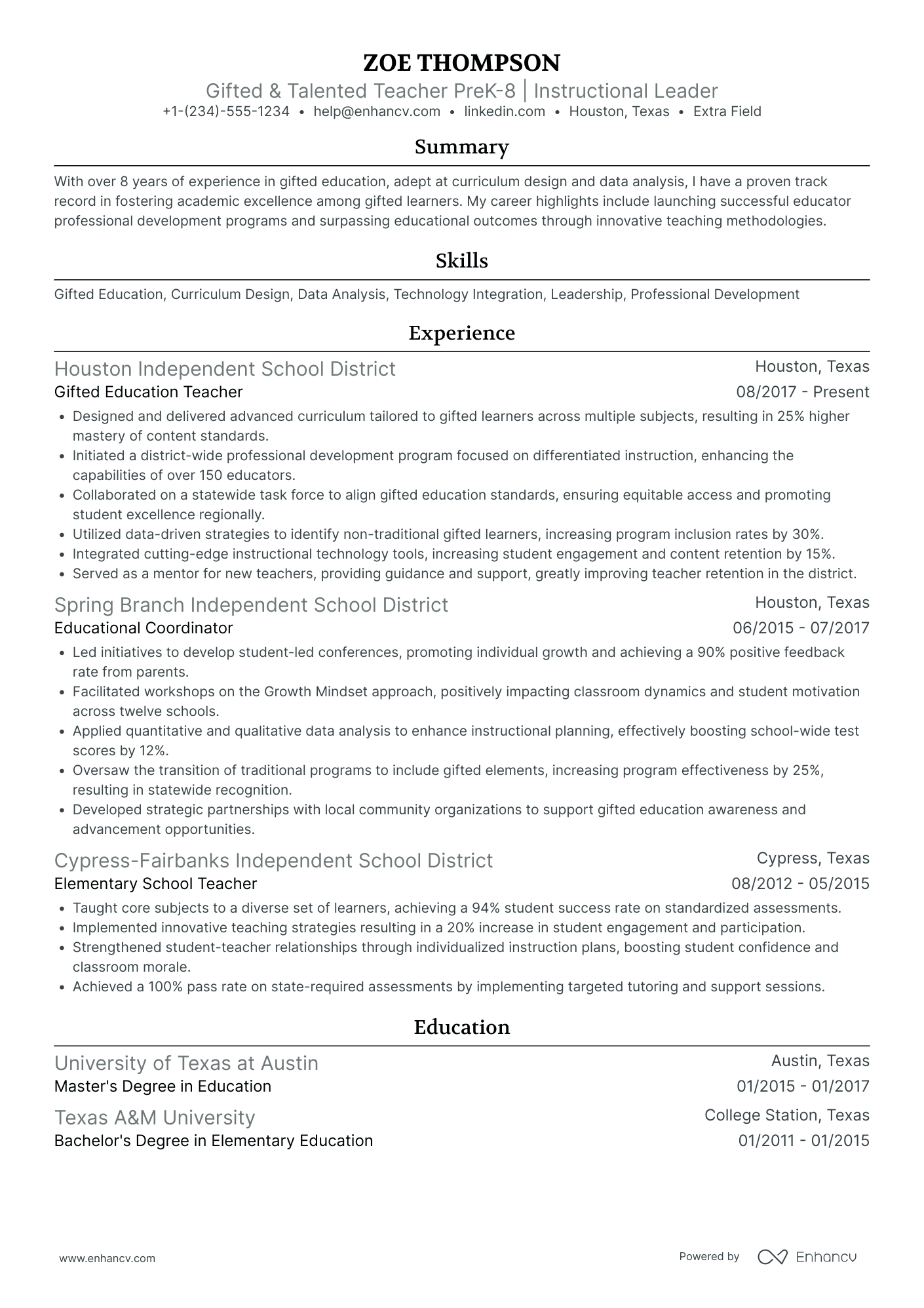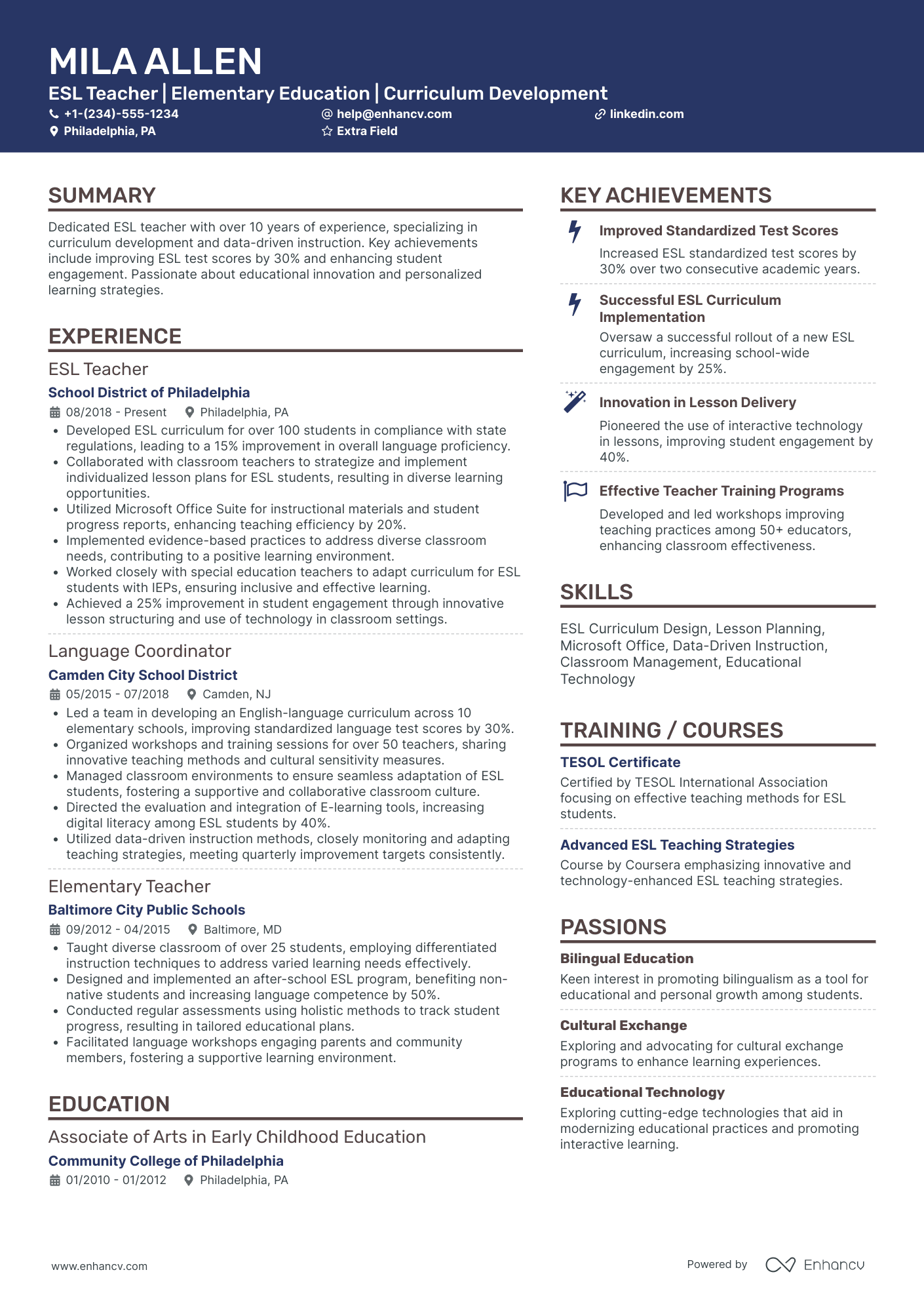Elementary school teaching is your passion. You’ve spent years pouring your heart and soul into arts, crafts, and field trips.
But with decreasing funding and increasing class size, elementary teachers are struggling to meet the individual needs of their students.
In today’s climate, elementary teachers need to be able to create fun and engaging lessons for each of their students’ unique learning styles, all while managing a busy classroom with little help from outside resources!
Your elementary teacher resume must show school administrators that you are a pro at everything from differentiated learning to student behavior management.
In this guide, you’ll learn:
- The right elementary teacher resume skills to impress school administrators
- What elementary teacher resume templates to use that will stand out from other candidates
- How to increase your chances of securing an interview by highlighting quantifiable achievements
- How to write an elementary teacher resume objective that shows principals how you will impact success at their school
- The best way to present your teaching certifications and education so that hiring managers know that you’re qualified for the job
Check these additional resumes for teaching positions:
Elementary Teacher resume examples
By Experience
By Role
How to format an elementary teacher resume
Your resume format is the first thing recruiters will notice and is your opportunity to make a good first impression. It helps to send a clear message as to who you are as a candidate.
There are several resume layouts, but the best choice for your elementary teacher resume is a reverse chronological layout.
As the name suggests, this layout lists your work history in reverse chronological order.
Elementary teaching typically follows a linear career path that begins with student teaching and leads to teaching your own class.
Reverse chronological is the optimal design to showcase your career growth.
What design elements should I use on my elementary teacher resume?
Creativity is an important skill for elementary teachers. Think back on some of the best classrooms you’ve seen and notice all the bright colors, fun activities, and innovative lessons.
Showing recruiters your creative side begins the moment they lay their eyes on your resume.
For elementary school teachers, it’s a good idea to make use of different colors, sections, and fonts. Show administrators what they can expect from your colorful classroom activities and fun lesson plans!
However, don’t get too carried away. The design should be organized, professional, and pleasant to look at. Remember your resume is for the staff, not the students.
Choose from the selection of colors, fonts, and other design elements in our resume builder to help you create a resume that will be appealing to hiring managers.
How many pages should my elementary teacher resume be?
A common question in resume writing is how many pages should a resume be. For elementary school teachers, one page is sufficient.
Resumes longer than one page are more common in higher-level school administrative roles by candidates with more than a decade of experience in education.
If by chance your target school does want to see a more detailed history or teaching portfolio, that will come later in the hiring process.
Should I use a PDF or doc file format for my elementary teacher resume?
Another common resume question is what is the best format to use - PDF or doc. Unless the job description explicitly requests a particular format, go with PDF.
Using a PDF provides more security and eliminates the risk of any unwanted formatting changes or compatibility issues.
School administrators are dealing with digital files and documents all day long. If they have difficulty opening yours, they won’t waste time on it.
You also want to ensure that your format is clear, concise, and ATS-friendly. Both our double-column and single-column layouts in Enhancv’s resume builder are ATS optimized.
Think about the market’s preferences – a Canadian resume, for instance, could have a different layout.
The top sections on an elementary teacher resume:
- Reverse chronological experience section
- Key strengths and skills for the job
- Education and qualifications that make you the right fit
- Summary that highlights your objective and greatest achievement
- Additional sections that showcase your value in the industry
What recruiters want to see on your resume:
- Classroom Management
- Lesson Planning
- Empathy or Social-Emotional Learning Competencies
- Instructional Strategies
- Behavior Management
- Educational Technology
- Teaching License and Certifications
- Specialty Training Programs like Orton-Gillingham or the Wilson Reading System
Schools today are facing more and more difficulties with proper funding and manageable class size, which puts stress on both teachers and students.
It is important that elementary teachers have good classroom management skills and exercise empathy when addressing student behavior issues. Elementary schools want teachers who are equipped to handle these challenges.
Larger class size means more students with diverse learning needs. Strong lesson planning skills that make learning engaging and accessible for everyone is key.
Educational technology is a rapidly growing arena. As EdTech becomes more and more integrated in classrooms, potential employers expect their teachers to keep up.
Increase your value in the industry and keep your skills relevant by staying on top of educational technology tools and trends.
A state teaching license is non-negotiable for virtually any elementary teacher position. We will get into more detail on this below, but be sure to display your required certifications clearly on your resume.
Don’t miss out on an opportunity by overlooking a crucial qualification!
How to write your elementary teacher resume experience section
Your experience section is key in showcasing why you’re the right candidate for the job. It’s an opportunity to highlight past successes and skills you’ve acquired on the job.
Follow the reverse chronological structure by starting with your most recent elementary teaching position. List each relevant job title, company name, company location, and date range you worked.
Under each job, list 4-6 bullets that highlight specific achievements with measurable results.
A common mistake people make here is listing a basic job description instead of personal achievements.
Recruiters and potential employers already know what an elementary school teacher does. They want to know what unique success you will bring to their school.
Include accomplishments with specific numbers and data. Don’t expect potential employers to take your word for it. Support your claims with evidence.
Experience bullets are also a good opportunity to show competency with job-specific tools and software. Include industry terms, awards, and tools. Mention things like class sizes and your strongest subject areas.
Pro Tip
Try using the PAR (Problem-Action-Result) method to determine quantifiable achievements. Identify a relevant problem, discuss the action you took to address it, and state the measurable result you achieved.
Start each bullet point entry with an action verb for maximum impact. Avoid overused or meaningless buzzwords.
A key piece of advice is always tailor your resume to fit your target job. This goes for every section of your resume, not just your experience section.
Recruiters have a lot of resumes to read and they don’t want to waste time sorting through irrelevant information.
Make sure every section of your resume is clear, concise, and relevant to the job you’re applying for.
How to quantify impact on your resume
Showing measurable results of past achievements can be easier said than done. It might be difficult to identify quantifiable data of previous accomplishments.
Simply writing “good communication with parents” or “high student pass rate” isn’t enough. It leaves things open to interpretation and doesn’t show recruiters why you’re a competitive candidate.
Let’s look at an example of common errors made in the experience section.
- •Selected and implemented curriculum
- •High student success rate
- •Good communication with parents
What doesn’t work in this example:
- Boring, general statements
- No quantifiable data
- Blanket claims left up to interpretation
Let’s look at an example below that provides quantifiable data to back up those claims.
- •Selected Social-Emotional Learning Certified curriculum and implemented using differentiated instruction
- •Achieved 98% student pass rate 2 years in a row
- •Received Parent Favorite award in 2019 for providing good communication and strong support to parents
What works in this example:
- Shows industry specific skills and knowledge
- Highlights quantifiable success with percentages
- Provides award as evidence to support claims
Let’s look at another example of generic elementary teacher experience sections.
- •Had positive classroom environment
- •Supported students with special learning needs
- •Improved test scores
What doesn’t work in this example:
- Generic terms with no specific examples
- Broad claims without supporting evidence
- Lacks strong action verbs
Let’s take a look at an improvement of the above example.
- •Created positive classroom environment through culturally responsive teaching strategies
- •Trained in Orton-Gillingham method to support students with dyslexia and other special learning needs
- •Improved test scores by an average of 19% in first year teaching
What works in this example:
- Shows knowledge of classroom strategies
- Highlights specialized training
- Provides measurable evidence to support claims.
There is a wide range of accomplishments you can select to highlight success. It is specific to each candidate and what is most relevant to the target job.
Here are a few more examples of quantitative data that can be used to strengthen an elementary school teacher resume:
- Class size
- Test scores
- Grade averages and improvements
- Teaching awards
- Behavioral management
- Attendance and dosage
- Student participation
- Parent satisfaction
- School rankings
- Literacy growth
How to list your hard skills and soft skills on your resume
Skills are an important part of your elementary teacher resume. They show your industry knowledge and ability to do the job.
Soft skills often require more explanation than hard skills. For this reason, it’s best to separate resume skills into two categories.
Let’s start with hard skills. Simply put, hard skills are the ability to perform job-specific tasks. These are usually technical and measurable abilities.
Unlike soft skills, there is less room for interpretation. Depending on their specificity, you often either have them or you don’t. As opposed to other skills which may be measured over a wide proficiency spectrum.
For hard skills, it’s okay to simply list them on your resume without an explanation of each skill. Let’s look at an example of a hard skills section on an elementary teacher resume.
If you have a lot of skills to list, you may want to separate them by category.
What works in these examples:
- Clear categories makes it easy to read
- Shows industry specific skills and knowledge
- Highlights relevant technology and software
Since you’re listing hard skills without context, be weary of including anything you’re not proficient in. If it’s on your resume, companies will assume you’re an expert.
List only the skills that you’re most confident in and are most relevant to your target job and of course, never lie on your resume by including skills you don’t have.
16 of the best hard skills for your elementary teacher resume
- Curriculum Development
- Differentiated Instruction
- Distance Learning
- Google Classroom
- Student-Centered Instruction
- Lesson Planning
- Assessment and Evaluation
- Classroom Management
- ClassDojo
- Remind
- Educational Technology
- Instructional Strategies
- Smartboard
- Kahoot
- Classroom Management Systems
- Learning Environment
Soft skills are not as black and white as hard skills. Therefore, it is best to include examples to show exactly what you mean.
You can do this throughout your resume by including examples in your experience bullets or achievements section.
A good way to highlight your best soft skills on your elementary teacher resume is to create a separate section for strengths.
Let’s take a look at the example below.
Note how the example above provides specific examples to support each soft skill. This makes it easier for potential employers to understand the impact you’ll have in your role.
16 of the best soft skills for your elementary teacher resume
- Time Management
- Critical Thinking
- Problem Solving
- Empathy and Compassion
- Creativity
- Communication
- Collaboration
- Leadership
- Patience
- Conflict Resolution
- Adaptability
- Public Speaking
- Innovation
- Active Listening
- Professional Development
- Organization
As with every section, tailor your skills to fit your target job. Take inventory of your skill set and select those that are most relevant.
When in doubt, seek help from friends and trusted colleagues to come up with a list of your best hard and soft skills.
How to list your certifications and education on your elementary teacher resume
Certifications and education carry significant importance on your elementary teacher resume.
Elementary teaching jobs will usually have minimum requirements like a state teaching license and a bachelor’s degree in education.
Some schools may require additional training in your subject area. Depending on your subject area and career goals, you may even consider obtaining a master’s degree.
Due to their importance in the industry, certifications, and education are qualities you want to highlight on your elementary teaching resume.
Your education section doesn’t require much detail. In fact, minimalism is better.
A basic education section includes:
- The name of the degree
- Issuing institution
- Location
- Years attended
Let’s look at an example of an elementary teacher resume education section.
If you have significant awards, courses, or projects from your education, you may consider including them as well. However, in most cases just the basic info is sufficient.
Your certification section will be similarly basic. Including just the name of the certification and issuing institution is fine.
{ "record": "CertificateSection", "name": "", "items": [ { "record": "CertificateItem", "title": "Florida Educator's Certificate", "issuer": "The Florida Department of Education", "showIssuer": true } ] }
Always follow instructions in the job listing. If the job application requires specific information like GPA or coursework, do as directed.
Be sure to thoroughly research your target job and find out what specific certifications are required for your role.
Here are a few general certifications that may be requirements or can increase the value of your resume.
7 certifications for your elementary teacher resume in 2026
- Teaching license or certificate issued by your state department of education
- Orton-Gillingham Practitioner Certification
- Wilson Reading System Certification
- Center for Effective Reading Instruction Certification
- American Sign Language Teachers Association Certification
- Reading or other subject area specialist certificate
- Social-emotional learning specialist certificate
Elementary teaching jobs will usually require some combination of background checks and child safety clearances that vary by state.
Most schools will run their own background checks during the hiring process, however many clearances remain valid for 1-5 years and can be presented to potential employers.
Show your target school that you’re committed to your career by including active clearances on your resume.
How to write your elementary teacher resume summary or objective
Your resume summary, or objective, is your personal introduction to recruiters and potential employers.
It shows your value in the industry and highlights the number one thing you want readers to know about you as a candidate.
It can be difficult to boil down all your experience and accomplishments in 3-5 sentences. A good formula to follow is to introduce your title, highlight your best achievement, and share a common goal.
Let’s look at an example of what not to do in your resume summary or objective.
What doesn’t work in this example:
- Broad statements with no real impact
- No mention of specific achievements
- Does not include goals
Let’s look at a revised version of the above example.
What works in this example:
- Includes specific numbers and percentages
- Supports claims with evidence
- Provides mutual goal of candidate and employer
Before you write your resume summary, do some research on your target employer. Find out what goals they have and how you can help achieve them.
Optimize your resume summary and objective for ATS
Drop your resume here or choose a file.
PDF & DOCX only. Max 2MB file size.
Additional sections for an elementary teacher resume
Depending on your role, subject area, and experience, you may want to include additional sections on your elementary teacher resume.
If you have unique experiences that make you a great candidate for the job, they can have a big impact on your resume.
Languages, volunteer work, and even hobbies can make great additions to your resume. Just make sure they’re relevant to your target job.
If you worked on relevant projects while student teaching or in pursuit of your degree, consider adding them to your resume.
Attaching a cover letter to your elementary teacher resume
Cover letters are not always required, but they can be a great tool to enhance your job application.
Cover letters provide an opportunity to dive deeper into specific experiences or achievements that you can’t fit on your resume.
They allow for a bit of storytelling and are a great way to show potential employers a side of your personality. When selecting a candidate, employers also want to know how they will fit into the company culture.
Like your resume, your elementary teacher cover letter should be clear, concise, and tailored to your target job. It should be organized, professional, and no longer than a page.
Use an attention-grabbing opening, a body that highlights your best qualities, and a closing with a call to action to show employers that you’re the right candidate for the job.
If you need more guidance on cover letter writing, browse our huge collection of cover letter examples by industry and role.
Key takeaways for writing a great elementary teacher resume
Now that you’ve gone through our guide, you’re ready to get to work on your amazing elementary teacher resume.
Let’s review how to write the best resume for elementary teachers:
- Use the reverse chronological format to make it easy for potential employers to review your work history and experience
- Include competitive skills and qualifications that recruiters look for
- Quantify the impact of your resume by including measurable results of past successes
- Organize your hard skills and soft skills in a way that highlights your best and most relevant qualities
- Consider including additional sections to stand out from other elementary teaching applicants
- Attach a cover letter to introduce yourself and enhance your application
Now you’ve got an outstanding elementary school teacher resume that’s ready for a gold star!
Frequently asked questions about elementary teacher resumes
What does a current elementary teacher's resume look like?
Every candidate is unique, so no two resumes will look exactly alike. However, there are some common qualities for a strong elementary teacher resume.
A one-page, reverse chronological resume in PDF format is a good standard. Use different colors, fonts, and organized sections to stand out from other candidates.
Browse our collection of resume examples by category for inspiration.
Where can I find free elementary teacher resume templates?
Enhancv has a large collection of resume templates that can be edited and downloaded in our resume builder.
You can also find additional resume templates through other online resume builders and word processors.
What should I put on my elementary teacher resume?
Your elementary teacher resume should include a header with clear contact info, a summary that introduces you to recruiters, and a work history that highlights your greatest achievements.
Read through our guide above for further advice on how to craft an elementary teacher resume that will help you get one step closer to your next job.
